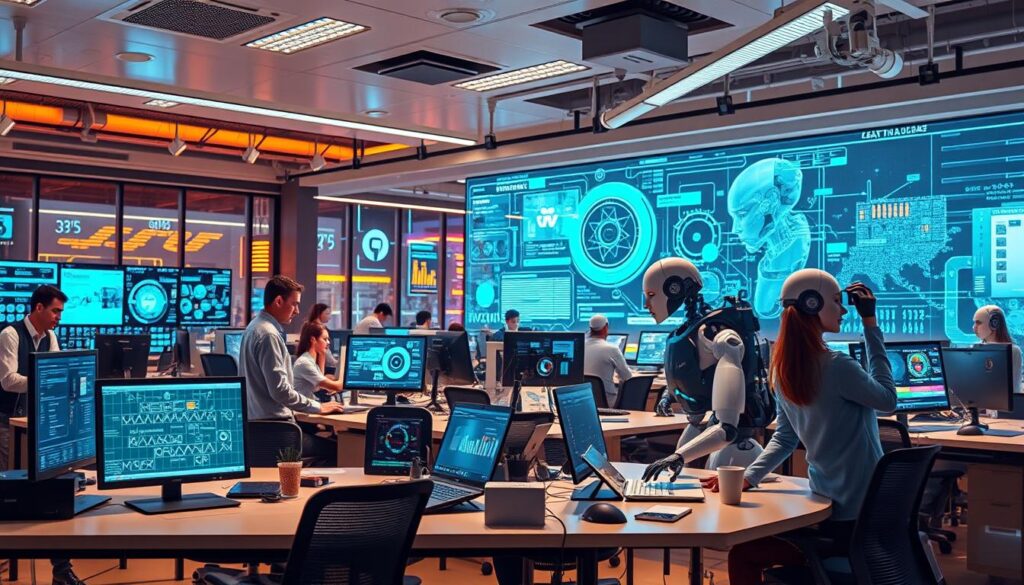GenAi, a new kind of artificial intelligence, is changing how businesses work. It automates tasks, freeing up people to focus on important decisions. A big 86% of IT leaders think GenAi will soon lead the way in companies, speeding up work1.
Also, 57% see GenAi as a major game-changer for business workflows. It’s becoming a must-have for today’s companies1.
Using GenAi makes businesses more efficient and productive. This is key in today’s fast-paced world. It helps cut costs and encourages creativity and new ideas. For example, AI helps companies understand their digital transformation better, changing old business ways2.
Goldman Sachs thinks GenAi could make the world 1.5% more productive. This could add about $7 trillion to global GDP over the next ten years1.

Key Takeaways
- 86% of IT leaders see GenAi as a key player in organisational change.
- GenAi automation drives significant efficiency and productivity gains.
- Reduced operational costs while fostering a creative and innovative work environment.
- Goldman Sachs predicts GenAi could boost global GDP by $7 trillion over the next decade.
- GenAi provides actionable insights, aiding deeper digital transformation.
The Rise of GenAI in Business Workflows
Generative AI (GenAI) has changed how businesses work. It’s a big step from old automation to new AI systems. GenAI learns from data and patterns, unlike old AI.
GenAI makes things faster. For example, it can set up infrastructure in minutes, not days. This helps many businesses, like insurance and banking, to change a lot3.
GenAI can make new, human-like things. It learns and adapts, unlike old AI. In healthcare, GenAI apps help patients by analyzing medical records, making things more efficient3.
Big tech companies like Google and Microsoft are working on GenAI. They’re making tools that help GenAI grow. This shows how fast and important GenAI is becoming in business4.
AI has come a long way. GenAI is more advanced than old AI. It’s changing how we work and live.
| Aspect | Traditional AI | GenAI |
|---|---|---|
| Functionality | Static, Task-Specific | Dynamic, Continuously Evolving |
| Application | Rule-Based Systems | Agent-Based Models |
| Implementation Time | Long Setup Time | Faster Deployment |
| Scalability | Limited | Highly Scalable |
GenAI is also changing the economy. McKinsey says it could add $6.1 trillion to $7.9 trillion a year. A survey in 2023 showed more companies are using GenAI, which is good for business5.
GenAI is not just useful; it’s also making things safer. It helps companies follow rules and use resources well. It’s also changing jobs, helping companies find workers when they’re hard to find5.
Benefits of GenAI Automation
GenAI automation brings big wins to businesses, making them more efficient and saving money. It boosts productivity a lot. AI can speed up tasks like making content, designing, and analysing data, making things faster and better6.
By automating tasks, businesses can cut down on labour costs. This means they can use their resources better6. AI also gives consistent, top-notch results, improving accuracy in tasks like design and data analysis6. This leads to better quality work, helping the business run smoother.
- GenAI makes it easy to handle big tasks, like making lots of product descriptions and analysing big data6.
- It’s also super flexible, fitting into many areas of a business. From making robots work in factories to helping with customer service, AI’s uses are wide-ranging.
An IBM survey found 35% of people think generative AI will be a big deal for businesses in the next few years7. This shows GenAI is seen as a smart choice for saving money and getting things done faster. By 2024, tools like AI and RPA could cut costs by up to 30%7.
| Benefit | Impact |
|---|---|
| Scalability | Helps firms handle big tasks and more work without needing more people6. |
| Flexibility | Works well in many areas, from making things to helping customers6. |
| Cost Reduction | Could cut costs by up to 30% by 2024 with tools like AI and RPA7. |
| Efficiency | Makes things faster, cuts down on time, and makes work better and more precise6. |
2024 is seeing a big rise in GenAI use8. GenAI sparks new ideas and solutions, boosting creativity6. Businesses using GenAI can make things smoother, reduce delays, and let staff focus on important tasks. It’s a key tool for making work better and saving money7.
Key Technological Components
GenAI is built on three main technologies: Machine Learning, Natural Language Processing (NLP), and Data Analytics. These work together to bring advanced features to industries. This helps them grow and succeed in the digital world.
Machine Learning models that learn from feedback are key to GenAI’s success. A McKinsey survey found that 50% of companies use AI in at least one area. This number is growing every year9. This shows how important strong machine learning is for handling big data and making useful insights.
NLP is also vital for GenAI. It lets systems understand and respond to human language well. This tech is crucial for better user experiences and improving work in finance and healthcare9.
Data Analytics is essential for GenAI to reach its full potential. Companies with lots of clean data can use GenAI best. Good data management is key for AI success10. For example, telecoms have cut costs by 20% with AI like GenAI10.
GenAI can now understand and use visual data much better than before. This has opened up new possibilities in manufacturing and retail. It makes production more efficient and customer experiences better9.
AI systems need constant updates to stay effective. This means always improving and fine-tuning algorithms. A BCG study found that focusing on key AI areas leads to better results9.
| Component | Description | Impact |
|---|---|---|
| Machine Learning | Algorithms that improve automatically through data | Enables predictive analytics and efficient operations |
| Natural Language Processing | Allows machines to understand and generate human language | Improves user interactions and automates supports |
| Data Analytics | Techniques for analysing datasets | Facilitates decision making and operational improvements |
| Computer Vision | Technology enabling machines to interpret visual data | Enhances quality control and customer insights |
| Algorithm Optimisation | Regular updates to maintain computational efficiency | Ensures AI systems perform at their optimal level |
Application of GenAI in Various Industries
Generative AI (GenAI) is changing many industries fast. It’s making operations more efficient. In Manufacturing, GenAI links robots with production data to make things faster. This cuts down the time to market a product by a lot11.
GenAI also helps make digital twins. These digital copies let manufacturers test and improve things without stopping real production11.
A McKinsey report shows GenAI can make manufacturing 21% more productive. It can pay off in one to three years, as seen in an automotive supplier’s case11. It also cuts down the need for quality control staff by 65% and makes inspections better11.
In Healthcare, GenAI is making patient care more personal. It uses data to predict what patients need. This helps doctors give better care12.
In Financial Services, GenAI is changing how banks work. It helps with risk, fraud, and investment. McKinsey says GenAI could add $200 billion to $340 billion to banking’s value12.
GenAI is also big in marketing. Gartner says 30% of marketing materials will be made with GenAI by 202512. Its use in different fields shows its power and versatility.
GenAI could add $2.6 trillion to $4.4 trillion to the global economy. It’s leading the way in tech. As more industries use it, business will change a lot12.
Challenges and Considerations
Integrating Generative AI (GenAI) into work brings up many challenges. Keeping data protection and handling privacy concerns is key. A big worry is bias, with 68% of leaders and developers concerned13. Also, following complex rules and keeping data safe is vital for trust.
Money is another big issue. For example, OpenAI’s GPT-4 cost around $78 million to make. Google’s Gemini Ultra training cost a whopping $191 million13. These costs show how much money is needed for top AI.
It’s also important to train workers for new AI tools. About 64% of developers want to use GenAI, but many think their companies need better skills13. Investing in training is key to closing this skills gap.
AI systems can also have bias. Over half of senior IT leaders say getting unbiased data is crucial for GenAI to work well13. Even though GenAI can change many fields, using it ethically is essential14.
- In healthcare, GenAI speeds up research and makes treatments better.
- In finance, it helps predict risks and find fraud.
- In marketing, it makes ads more personal and boosts sales.
As we move forward, we must focus on data protection and privacy concerns, following rules, and using AI ethically14. Making sure our investments match these goals will help us innovate responsibly.
How GenAi Automation is Revolutionising Business Workflows
Looking at Real-World Case Studies, we see GenAI changing many industries. It’s making fintech and health sectors better with predictive analytics and smart automation. For example, GenAI cuts down on manual work and costs, making systems more reliable15. The banking world benefits a lot, catching fraud by looking at transaction patterns15.
GenAI is great at handling big data, spotting patterns, and offering quick solutions. It boosts cybersecurity, keeping businesses safe from cyber threats. In 2023, 69% of big companies faced cyber-attacks, showing how crucial strong cyber-defences are16. It also helps in spotting user behaviour that might risk compliance, helping to avoid problems16.
In healthcare, GenAI helps make treatment plans tailored to each person’s needs. It checks the quality and safety of drugs and devices by analysing data15. Health insurance companies use GenAI to make claims processing smoother15. It also makes customer service better by offering personal services and targeted marketing15.
GenAI’s use in real life teaches us about planning and doing things right. Successful AI use comes from knowing what you want to achieve and what might get in the way. As GenAI keeps getting better, it will open up new possibilities for businesses to excel.
Let’s look at some Real-World Case Studies in brief:
| Industry | Implementation | Outcome |
|---|---|---|
| Finance | Fraud Detection | Enhanced Security15 |
| Healthcare | Customised Treatment | Better Patient Outcomes15 |
| Insurance | Claims Processing | Streamlined Operations15 |
| Customer Service | Personalised Marketing | Improved Customer Engagement15 |
Conclusion
Embracing GenAI is crucial for businesses to succeed in the future. Our analysis shows companies see its huge potential. Yet, the path to full integration is different for everyone.
Currently, 42% of businesses are testing AI, showing they’re still exploring17. On the other hand, 17% have successfully used AI in many areas, showing they’ve made progress17.
GenAI greatly improves business processes. It boosts efficiency and helps make better decisions. But, it also comes with risks and challenges.
For example, in 2023, over 17 billion records were stolen in data breaches18. This shows even advanced tech has weaknesses. Security is a big worry, with 53% of companies facing new AI threats18.
Our exploration of GenAI in business shows it’s key for future plans. Only 8% of businesses have AI at their core17. Cybersecurity is also a big challenge, with 55% of IT leaders feeling outmatched by cyber attackers18.
As we move into the GenAI era, its integration will change automation and business processes. It will help companies stay competitive in a digital world.
Source Links
- https://www.rezolve.ai/blog/genai-powered-workflow-automation
- https://iwconnect.com/using-generative-ai-genai-for-process-automation/
- https://medium.com/@zisa.consulting/the-genai-enterprise-transforming-business-through-intelligent-automation-32b871d846b9
- https://www.mckinsey.com/capabilities/mckinsey-digital/our-insights/why-agents-are-the-next-frontier-of-generative-ai
- https://www.ceo-review.com/the-rise-of-generative-ai-in-business-readiness-use-cases-and-challenges/
- https://www.solulab.com/generative-ai-automation/
- https://research.aimultiple.com/automation-with-generative-ai/
- https://www.activepieces.com/blog/5-best-generative-ai-automation-techniques-for-2024
- https://milestone.tech/ai-and-automation/identifying-the-right-genai-use-cases-for-maximum-impact/
- https://www.linkedin.com/pulse/establishing-effective-ai-strategy-key-components-industry-ali-97jgf
- https://www.alpha-sense.com/blog/trends/generative-ai-manufacturing/
- https://www.coursera.org/articles/generative-ai-applications
- https://www.linkedin.com/pulse/challenges-implementing-genai-auxiliobits-w815c
- https://amazic.com/10-regulatory-challenges-with-genai-and-steps-to-overcome-them/
- https://www.firstsource.com/blog/genai-infused-automation-the-next-wave-of-digital-operations/
- https://www.business-reporter.co.uk/ai–automation/five-ways-genai-can-improve-your-business
- https://www.vationventures.com/session-summaries/generative-ai-augmentation-vs-automation
- https://www.forbes.com/councils/forbestechcouncil/2024/07/31/generative-ai-closing-the-tech-gap-between-cyber-teams-and-criminals/
















